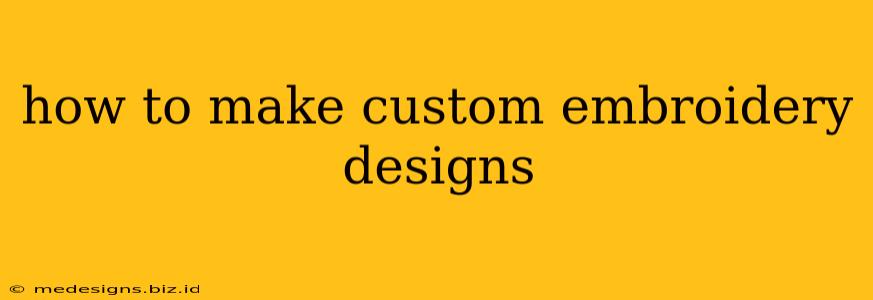Embroidery is a timeless craft, allowing you to create personalized and unique designs on clothing, home decor, and more. Learning how to make your own custom embroidery designs opens up a world of creative possibilities. This guide will walk you through the process, from initial concept to stitching your masterpiece.
Choosing Your Embroidery Design Software
Before you start stitching, you'll need the right tools. The first step is selecting embroidery design software. There are several options available, ranging from free programs to professional-grade software packages. Consider your budget and skill level when making your choice. Popular choices include:
- Free Software: Many free options offer basic design capabilities. These are excellent for beginners experimenting with simple designs. Search online for "free embroidery design software" to find several options. Limitations may include fewer features and stitch types compared to paid versions.
- Paid Software: Paid software typically offers more advanced features like digitizing, a wide variety of stitch types, and better control over stitch density and detail. Research options to find software that suits your needs and budget. Popular examples include Embird and Stitch Era.
Key Features to Look For in Embroidery Design Software:
- Digitizing Capabilities: This allows you to convert your artwork into a format that your embroidery machine can read.
- Stitch Editing: The ability to adjust individual stitches and stitch patterns for optimal results.
- Color Management: Proper color management ensures accurate color representation in your final embroidery.
- Import/Export Options: Compatibility with various image formats (like JPG, PNG, AI) is crucial.
Designing Your Custom Embroidery Pattern
Now for the fun part! Once you've chosen your software, you can start designing your embroidery pattern. Here are some tips:
- Start Simple: Begin with simple designs if you're a beginner. Mastering basic shapes and lettering is a great foundation before moving to more complex patterns.
- Sketch Your Idea: Before diving into the software, sketch your design on paper. This helps refine your ideas and visualize the final product.
- Consider the Fabric: The type of fabric you'll be embroidering on will influence your design choice. Dense fabrics might need simpler designs, while looser fabrics can handle more intricate details.
- Understand Stitch Types: Familiarize yourself with different stitch types available in your software. Each stitch type creates a different look and texture. Experiment to discover what works best for your design.
- Use Existing Images (with caution): You can use existing images as inspiration, but always respect copyright laws. Don't trace copyrighted images without permission.
Design Ideas for Beginners:
- Simple Geometric Shapes: Start with circles, squares, and triangles before moving onto more complex shapes.
- Lettering: Practice embroidering your name or a short phrase.
- Small Floral Motifs: Simple flowers are relatively easy to design and embroider.
Transferring Your Design to Fabric
Once you're happy with your digital design, it's time to transfer it to your fabric. Several methods exist:
- Embroidery Machine: If you own an embroidery machine, simply load your digital design into the machine and stitch away.
- Print and Trace: Print your design on printer paper and trace it onto your fabric using tracing paper or a water-soluble pen.
- Using a Projector: Project your design onto your fabric, and then trace it.
Embroidering Your Design
With your design transferred to the fabric, it's finally time to embroider! Make sure to use the right needle and thread for your fabric and design. Pay attention to tension and stitch consistency for a clean and professional finish.
Tips for Perfect Embroidery:
- Use a Stabilizer: A stabilizer will help prevent puckering and give your stitches a clean finish.
- Maintain Even Tension: Consistent tension prevents your embroidery from looking uneven.
- Take Breaks: Embroidery can be time-consuming. Take regular breaks to avoid eye strain and fatigue.
Optimizing your content for SEO
This article targets several keywords related to custom embroidery design, including "custom embroidery designs," "embroidery design software," "designing embroidery patterns," "transferring embroidery designs," and "embroidery techniques". The use of headings (H2, H3), bold text, and a clear structure improves readability and SEO. Linking to relevant resources (although not direct download links as requested) would further enhance SEO, as would promoting this post on social media and other platforms (off-page SEO).
By following these steps, you can create your own stunning custom embroidery designs. Remember to practice, experiment, and most importantly, have fun!
